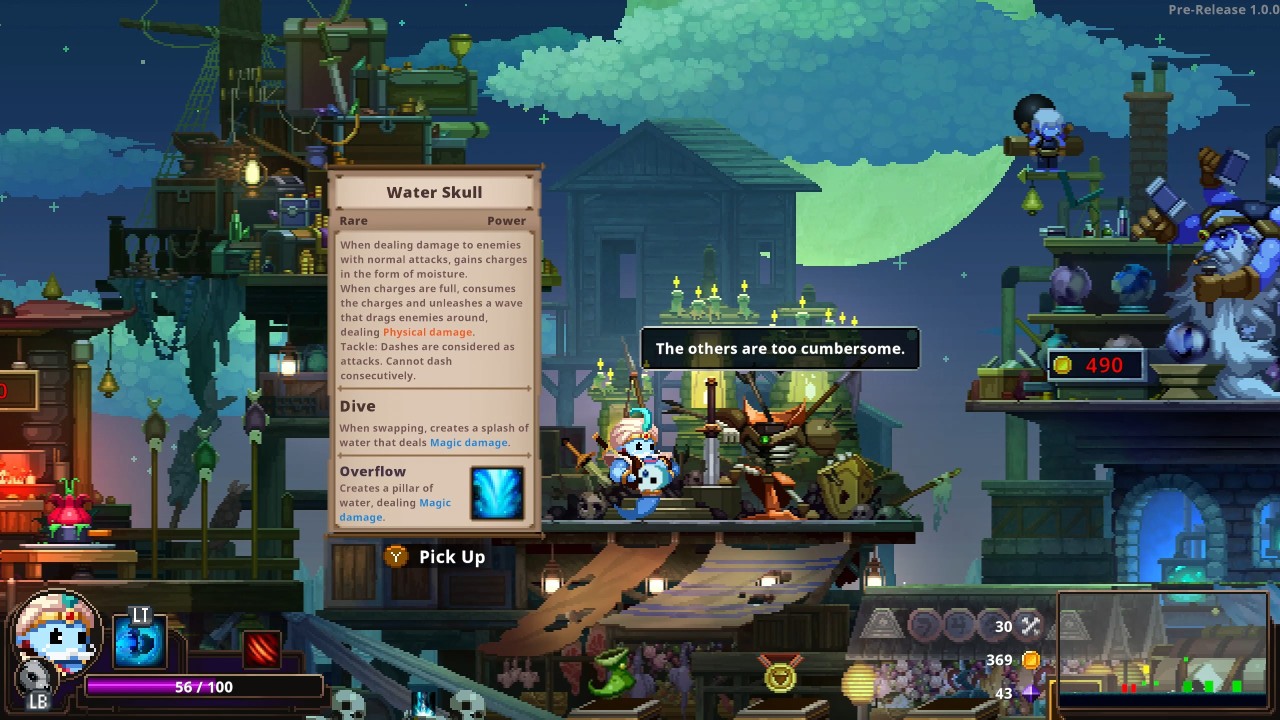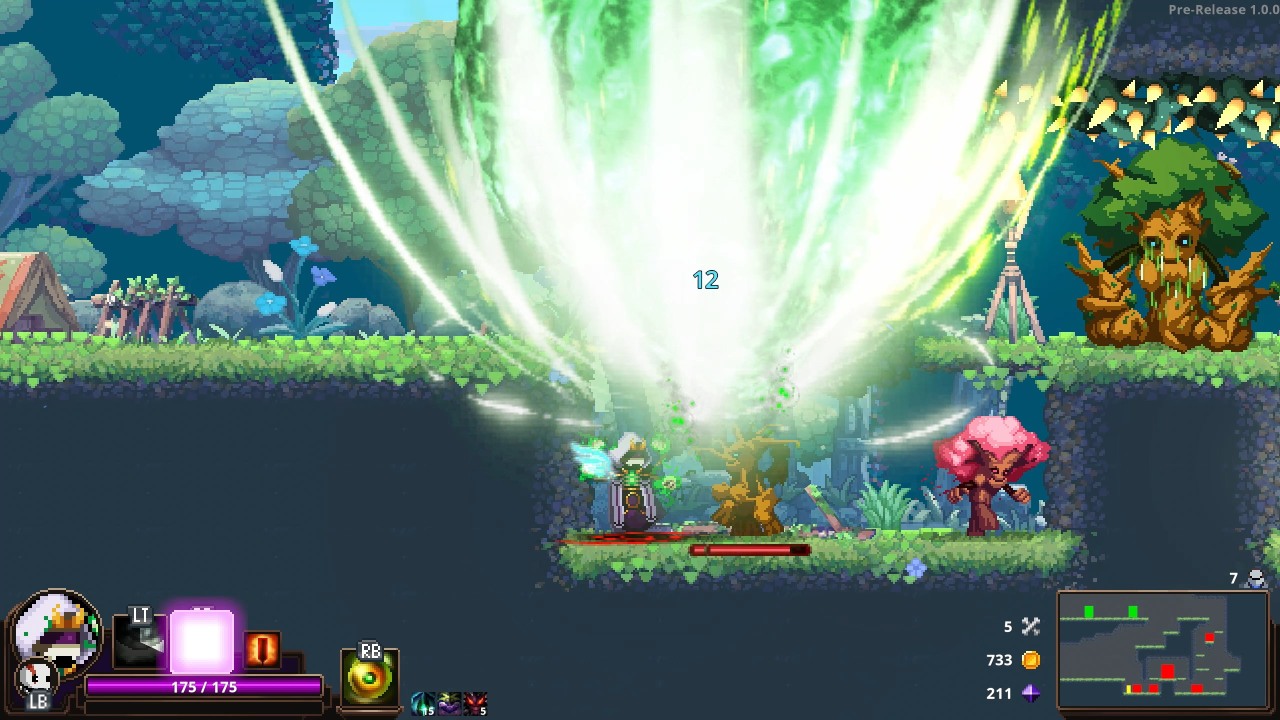Why play the hero when you can play a lowly skeleton on a quest to save the demon king from the humans that kidnapped him? That’s the idea behind Skul, the latest action roguelite to grace Steam and the first of many that I will likely be reviewing this year.
Pros:
Solid combat. The core to any good action roguelite is combat, and that is fortunately something you won’t have to worry about with Skul. Hits offer up ample feedback, the controls are intuitive, and there’s really no sense of clunkiness to it. It’s a very fast-paced game most of the time and there’s nothing like stamina meters to slow you down.
This is perhaps best seen in the movement, which is incredibly responsive. Want to cancel that attack and double dash to the side before flying back in with your next attack? No problem. There is so much movement to the combat that I was quite literally zipping around in most of the fights, especially so whenever I had a speed class equipped.
However, that is not to understate the game’s difficulty. This is an incredibly difficult game, especially at the start when you have barely any upgrades. Bosses will constantly stomp you, certain room layouts may be a guaranteed half-HP loss, and it can honestly be quite frustrating at times. However, it kept me coming back, even when it felt like I had hit a wall. If anything, that’s a testament to how fun the combat is.

Really cool skull mechanic. Alongside core combat, roguelites also need something differentiating each run, to avoid the game feeling repetitious or grindy. Skul may not be perfect here (which I’ll get into later), but it has a solid grasp on this concept. For one, I really liked the dynamic between the “skulls” that you can equip and regular items. The weapons and abilities you have at any given moment are granted by whatever skull you have equipped, and these skulls can be found as room rewards or in shops during each run. They’re basically classes, each revolving around some theme and some really changing the way you play the game.
For example, there’s one skull that has you equipped with a spear, allowing quick and easy attacks from a little bit of a range, with one of the abilities being to dash through groups of enemies spear-first. That’s one of the most basic skulls though. Then you get something like the gambler, a legendary skull with a much lower drop rate. This skull has you throw out 1-5 cards as your basic attack, with a 30% chance of one of those cards being an explosive joker card, with each joker card then having a 20% chance of failure and a 10% chance of a much bigger explosion. This applies to the class’ abilities too, with one throwing out 21 piercing cards and another throwing out dice that rain down darts based on what they landed on.

Those are just a couple examples of the variety offered by these skulls, and there are dozens to be found and even more so when you consider that most of them can be upgraded a few times to unlock different attacks and abilities. You can have two of these skulls equipped at any given moment, and each has a unique ability that activates when you swap to it. This gives the combat a nice layer of depth to it, as you’re basically encouraged to swap between skulls depending on the situation and I quite liked the dynamic there.
Great gameplay variety and progression. The variety doesn’t stop at just the skulls though, the game also has a decently sized enemy roster, some neat bosses, and your standard passive upgrades and stat buffs just like most other action roguelites. One upgrade may simply increase your attack speed while another may summon a familiar every time you attack. These work in combination with your skulls and I discovered some very cool synergies between them, such as the gargoyle skull and an upgrade that caused me to drop bombs every time I double jumped. Because the gargoyle can glide, it registers as multiple double jumps and I pretty much could just carpet bomb entire areas by flying over them.

Then there’s the progression, as this is a roguelite and not a straight-up roguelike. It mainly comes in two forms: demons that can be found on the map and jewels earned during a run that can then be spent on permanent stat upgrades. For each demon you bring back to the demon castle, you unlock the ability to start off the run stronger than just your default state. The first demon you unlock, for example, gives you a random skull to start with. The jewels are a bit more long-lasting, as they can grant stuff like permanent damage upgrades and even the ability to revive upon death with a certain amount of HP. If you’ve played Hades – it’s pretty much the same thing as the mirror upgrades.
Both of these give the game a nice sense of progression. It’s slow progression for sure, but enough that you’re not completely walled off when you feel stuck.
Nice pixel graphics. I won’t deny that a lot of roguelites use the same art style, but Skul is yet another example as to why they do. Detailed sprites, colorful backgrounds, cool visual effects, the art has a lot going for it here. The animations in particular were very nicely done, with each class getting its own fair share of animation work. It’s just a good-looking game in general and worked perfectly at 1440p 144 fps without any frame drops, stutters, or other such issues.

Cons:
Unbalanced items and skulls. Skul may do a lot right with regards to its gameplay variety, but as I played more and more, I couldn’t help but notice there was one big problem. To be specific, it’s that some skulls are clearly superior to others. Now that may sound like a given, but the problem is a bit more deep-rooted than that. Normally, in an action roguelite, you build up this arsenal of upgrades and items that keep stacking and synergizing with each other, changing the way the game is played as you progress.
In Skul, it’s not like there is none of that, but your success in a given run is much more reliant on you finding a legendary skull, regardless of what other items and such you may have. So instead of building up an arsenal of cool upgrades and such to synergize with each other, it becomes more of an RNG quest to find those few skulls that can get you through the boss fights. If you don’t find one by the second boss, it’s pretty much a dead run. That is why it took me almost five hours just to get past that second boss.

So, as much as I love some of the simpler skulls (especially when upgraded), they simply don’t compare to something like the Grim Reaper or the Gambler, which can absolutely shred bosses and entire rooms of enemies even without strong items backing them up. It feels great when you finally get one of these skulls, but I feel like the rest could use some balancing so I don’t feel like I’m handicapping myself by using a common skull.
Repetitive level design and music. As I said earlier, Skul’s gameplay variety is not perfect and this is best exemplified with its level design. Not even a couple hours into the game, I was already noticing a pattern with both level layouts and enemy placements, enough so that I could enter some rooms and immediately know where to go to get the best damage output as enemies spawned. Some may see this as a good thing, but I like it when a game can keep me guessing or at least offer enough room layouts that I don’t notice the patterns.

Then there’s the music, which by itself is not bad (although not great either) but is just so limited that it can become a bit grating. The first area, for example, you’ll run through so many times that that backing song becomes embedded into your brain, that same looping few-minute sequence over and over. The music does change once you get to a new area, but the game could desperately use a couple more tracks for each.
Notes:
Not necessarily a pro or a con, but there is a story to the game in the form of cutscenes in-between each area when you first access it. They’re extremely limited and honestly quite forgettable, but not enough to be any sort of issue, just thought I should mention that a story does in fact exist. The game also offers customizable controls on both keyboard and controller. I tried the keyboard controls and thought they were okay, but this is definitely a controller game.

Skul: The Hero Slayer is yet another example as to why I love action roguelites so much. It’s got the solid core combat, the excellent gameplay variety, and some nice pixel graphics to top it all off. It may not be perfect, especially on the grounds of balancing and level design, but it’s a very well-made game all things considered. If you’re a fan of such action roguelites, it is well worth a look.

Quote: Skul: The Hero Slayer is yet another example as to why I love action roguelites so much. Solid combat, excellent gameplay variety, nice graphics, it’s got a lot going for it.
You can buy Skul: The Hero Slayer on Steam here. Console editions are planned for later this year.
I was provided a review copy of the game in order to write this review. Read more about how I do my game reviews here.

